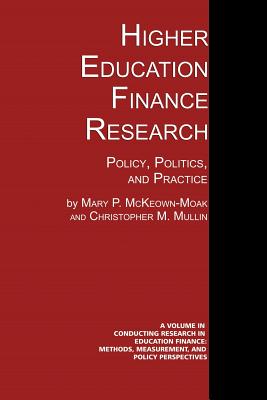Higher Education Finance Research: Policy, Politics, and Practice

Higher Education Finance Research: Policy, Politics, and Practice
A volume in Conducting Research in Education Finance: Methods, Measurement, and Policy Perspectives Series Editors David C. Thompson, Kansas State University and Faith E. Crampton, University Wisconsin-Milwaukee There is a void in the literature on how to conduct research in the finance and economics of higher education. Students, professors, and practitioners have no concise document that examines the field, provides history, definitions of terms, sources of data, and research methods. Higher Education Finance Research: Policy, Politics, and Practice fills that void. The book is structured in four parts. The first section provides a brief history and description of the general organization of American higher education, the sources and uses of funds over the last 100 years, and who is served in what types of institutions. Definitions of terms that are unique to higher education are provided, and some basic rules for conducting research on the economics and finance of higher education are established. Although in some ways, conducting research in higher education funding is similar to that for elementary/secondary education, there are some important distinctions that also are provided. The second section introduces guiding philosophies, sources of data, data elements/vocabulary, metrics, and analytics related to institutional revenues and expenditures. Chapters in this section focus on student oriented revenues, institutionally-oriented revenues, and funding formulas. The third section introduces accountability-related concepts by first examining the accountability movement in higher education and performance-based approaches applied in budgeting and funding, then looking at methods to determine public and private returns on investment in postsecondary education, and closing with an examination of finance from the perspective of the primary consumer: students. The fourth and last section of the book focuses on presenting postsecondary finance research to policy audiences to assist in connecting academic research and policy making. Chapters focus on accounting for time considerations in analysis, the placing of data in context to make the data and findings relevant, and ways to effectively communicate findings to various policy-making audiences.
PRP: 588.48 Lei
Acesta este Prețul Recomandat de Producător. Prețul de vânzare al produsului este afișat mai jos.
529.63Lei
529.63Lei
588.48 LeiLivrare in 2-4 saptamani
Descrierea produsului
A volume in Conducting Research in Education Finance: Methods, Measurement, and Policy Perspectives Series Editors David C. Thompson, Kansas State University and Faith E. Crampton, University Wisconsin-Milwaukee There is a void in the literature on how to conduct research in the finance and economics of higher education. Students, professors, and practitioners have no concise document that examines the field, provides history, definitions of terms, sources of data, and research methods. Higher Education Finance Research: Policy, Politics, and Practice fills that void. The book is structured in four parts. The first section provides a brief history and description of the general organization of American higher education, the sources and uses of funds over the last 100 years, and who is served in what types of institutions. Definitions of terms that are unique to higher education are provided, and some basic rules for conducting research on the economics and finance of higher education are established. Although in some ways, conducting research in higher education funding is similar to that for elementary/secondary education, there are some important distinctions that also are provided. The second section introduces guiding philosophies, sources of data, data elements/vocabulary, metrics, and analytics related to institutional revenues and expenditures. Chapters in this section focus on student oriented revenues, institutionally-oriented revenues, and funding formulas. The third section introduces accountability-related concepts by first examining the accountability movement in higher education and performance-based approaches applied in budgeting and funding, then looking at methods to determine public and private returns on investment in postsecondary education, and closing with an examination of finance from the perspective of the primary consumer: students. The fourth and last section of the book focuses on presenting postsecondary finance research to policy audiences to assist in connecting academic research and policy making. Chapters focus on accounting for time considerations in analysis, the placing of data in context to make the data and findings relevant, and ways to effectively communicate findings to various policy-making audiences.
Detaliile produsului









